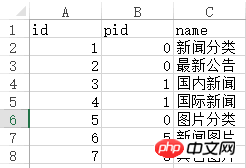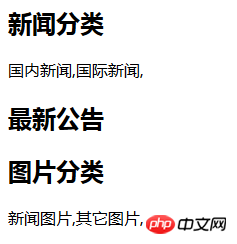
This article introduces the usage and examples of foreach in PHP, and introduces the usage of foreach in detail. Interested friends can refer to it.
Foreach is often used in PHP, and to use foreach, you must use an array. Therefore, in this article, we will talk about arrays and foreach at the same time.
foreach has two syntaxes:
The first one: traverse the given array statement array_expression array. Each time through the loop, the value of the current cell is assigned to $value and the pointer inside the array is moved forward one step (so the next cell will be obtained in the next loop).
foreach (array_expression as $value)
Second type: Same as above. At the same time, the key name of the current unit will also be assigned to the variable $key in each loop.
foreach (array_expression as $key => $value)
Let’s explain them one by one!
Recommended manual:php complete self-study manual
##1. One-dimensional ordinary array and foreach
We first write a one-dimensional array, as follows:$a = array('Tom','Mary','Peter','Jack');
foreach ($a as $value) {
echo $value."<br/>";
}Tom Mary Peter Jack
foreach ($a as $key => $value) {
echo $key.','.$value."<br/>";
}0,Tom 1,Mary 2,Peter 3,Jack
Summary: Obviously, we see that there is just one more $key, and the value of this $key is the serial number 1 , 2, 3, 4 and so on!
Recommended related articles: 1.
Two uses of PHP foreach as $key => $value 2.
In-depth understanding of the usage of foreach statement loop array
Related video recommendations:1.
Dugu Jiujian (4)_PHP video tutorial
2. One-dimensional associative array and foreach
The one-dimensional associative array is as follows:
$b = array('a'=>'Tom','b'=>'Mary','c'=>'Peter','d'=>'Jack');
$b = array( 'a'=>'Tom', 'b'=>'Mary', 'c'=>'Peter', 'd'=>'Jack' );
foreach ($b as $value) {
echo $value."<br/>";
}Tom Mary Peter Jack
foreach ($b as $key => $value) {
echo $key.','.$value."<br/>";
}a,Tom b,Mary c,Peter d,Jack
Summary: Obviously, in a one-dimensional associative array, $key is the associated serial number, that is, the corresponding a, b, c, d.
3. Two-dimensional ordinary array and foreach
When traversing a two-dimensional array, it is a little more troublesome. Why? Because the traversed value is an array. Since it is an array, you can perform various operations on the array! Let’s first look at a basic two-dimensional array, as follows:$c = array( array('1','Tom'), array('2','Mary'), array('3','Peter'), array('4','Jack') );
foreach ($c as $value) {
print_r($value);
echo "<br/>";
}
Array ( [0] => 11 [1] => Tom ) Array ( [0] => 22 [1] => Mary ) Array ( [0] => 33 [1] => Peter ) Array ( [0] => 44 [1] => Jack )
foreach ($c as $key => $value) {
echo '$key='.$key."<br/>";
print_r($value);
echo "<br/>";
}$key=0 Array ( [0] => 11 [1] => Tom ) $key=1 Array ( [0] => 22 [1] => Mary ) $key=2 Array ( [0] => 33 [1] => Peter ) $key=3 Array ( [0] => 44 [1] => Jack )
Summary: As can be seen from the above, the basic two-dimensional array, $key is the serial number, such as 0\1\2\3 and so on!
4. Associative two-dimensional arrays and foreach
Explain that associative two-dimensional arrays are used a lot in actual projects. Why? Generally, the data extracted from the database is associated with two-dimensional arrays. If you learn to associate two-dimensional arrays, you will have mastered a large part of it in actual PHP practice! Then first list the associated two-dimensional array, as follows:$d = array( array('id'=>'11','name'=>'Tom'), array('id'=>'22','name'=>'Mary'), array('id'=>'33','name'=>'Peter'), array('id'=>'44','name'=>'Jack') );
foreach ($d as $value) {
print_r($value);
echo "<br/>";
}Array ( [id] => 11 [name] => Tom ) Array ( [id] => 22 [name] => Mary ) Array ( [id] => 33 [name] => Peter ) Array ( [id] => 44 [name] => Jack )
foreach ($d as $key => $value) {
echo '$key='.$key."<br/>";
print_r($value);
echo "<br/>";
}$key=0 Array ( [id] => 11 [name] => Tom ) $key=1 Array ( [id] => 22 [name] => Mary ) $key=2 Array ( [id] => 33 [name] => Peter ) $key=3 Array ( [id] => 44 [name] => Jack )
5. Practical application in the project
Explanation: In the project, there are many changes in the array, and of course foreach contributes a lot! Of course, you can also use while, each, etc. methods, but foreach is the most convenient! Let’s briefly talk about some common project practices! Practical 1: Convert a two-dimensional associative array into a one-dimensional ordinary arrayStill the fourth list of associative two-dimensional arrays, as follows:$d = array( array('id'=>'11','name'=>'Tom'), array('id'=>'22','name'=>'Mary'), array('id'=>'33','name'=>'Peter'), array('id'=>'44','name'=>'Jack') );
foreach ($d as $key => $value) {
echo ($value['name']);
echo "<br/>";
}//获取name列作为一维数组
$nameArr = array(); //name列
foreach ($d as $key => $value) {
$nameArr[] = $value['name'];
}
print_r($nameArr);Array ( [0] => Tom [1] => Mary [2] => Peter [3] => Jack )
$d = array('Tom','Mary','Peter','Jack');
Practice 2: Two-level classification and unlimited classification
Obviously, the data we take out from the database is a two-dimensional array, and it is a two-dimensional association array. So, how do we extract the parent category? How to get out the subcategories corresponding to the parent category?首先要说明的是:几乎所有的分类都是一个数据库模式,因此我们十分有必要了解它的结构,还有怎么取出对应的数据!
对于二级分类,为了说明方便,我从网上找一个比较好说明的例子,那就是“新闻分类“!
好了,废话不多说,开始正题!我们先写一个数组。
//从数据库中取出的分类数据 $original_array = array( array('id' => 1,'pid' => 0,'name' => '新闻分类'), array('id' => 2,'pid' => 0,'name' => '最新公告'), array('id' => 3,'pid' => 1,'name' => '国内新闻'), array('id' => 4,'pid' => 1,'name' => '国际新闻'), array('id' => 5,'pid' => 0,'name' => '图片分类'), array('id' => 6,'pid' => 5,'name' => '新闻图片'), array('id' => 7,'pid' => 5,'name' => '其它图片') );
同时,数据库是这个样子的。

说明:数据库的分类就是这个样子的!取出来的数组也是这个样子的!一般这样子的!
//从数据库中取出的分类数据
$original_array = array(
array(
'id' => 1,
'pid' => 0,
'name' => '新闻分类'
),
array(
'id' => 2,
'pid' => 0,
'name' => '最新公告'
),
array(
'id' => 3,
'pid' => 1,
'name' => '国内新闻'
),
array(
'id' => 4,
'pid' => 1,
'name' => '国际新闻'
),
array(
'id' => 5,
'pid' => 0,
'name' => '图片分类'
),
array(
'id' => 6,
'pid' => 5,
'name' => '新闻图片'
),
array(
'id' => 7,
'pid' => 5,
'name' => '其它图片'
)
);那么首先我们得知道我们想要的结果是什么样子呢?这一点:我们必要知道!(以前我对这方面了解比较不深,又常用开源程序,因此导致我不怎么会写这方面了)
我们最终想要的结果是这样子的!(不怕大家笑话,这一点我请一个朋友帮的忙才解决的!)
//整理后的分类数据
$output_array = array(
array(
'id' => 1,
'pid' => 0,
'name' => '新闻分类',
'children' => array(
array(
'id' => 3,
'pid' => 1,
'name' => '国内新闻'
),
array(
'id' => 4,
'pid' => 1,
'name' => '国际新闻'
),
),
),
array(
'id' => 2,
'pid' => 0,
'name' => '最新公告',
),
array(
'id' => 5,
'pid' => 0,
'name' => '图片分类',
'children' => array(
array(
'id' => 6,
'pid' => 5,
'name' => '新闻图片'
),
array(
'id' => 7,
'pid' => 5,
'name' => '其它图片'
),
),
),
);很明显,这里数组多了一个字段,就是 children!
那么,怎么 从 $original_array 变为 $output_array呢?这里有我一个朋友做的函数,当然也用到 foreach!
函数如下:
//整理函数
/**
* 生成无限级树算法
* @author Baiyu 2014-04-01
* @param array $arr 输入数组
* @param number $pid 根级的pid
* @param string $column_name 列名,id|pid父id的名字|children子数组的键名
* @return array $ret
*/
function make_tree($arr, $pid = 0, $column_name = 'id|pid|children') {
list($idname, $pidname, $cldname) = explode('|', $column_name);
$ret = array();
foreach ($arr as $k => $v) {
if ($v [$pidname] == $pid) {
$tmp = $arr [$k];
unset($arr [$k]);
$tmp [$cldname] = make_tree($arr, $v [$idname], $column_name);
$ret [] = $tmp;
}
}
return $ret;
}那们怎么使用呢?
//整理函数的使用 $output_array = make_tree($original_array);
完整使用方法如下:
$output_array =make_tree($arr, 0, 'id|pid|children')
函数之后,我们这样调用就得到了一级分类与二级分类!
foreach ($output_array as $key => $value) {
echo '<h2>'.$value['name'].'</h2>';
foreach ($value['children'] as $key => $value) {
echo $value['name'].',';
}结果如下:

附:$output_array 这个数组,我们使用print_r,就可以得到如下的结果!
Array
(
[0] => Array
(
[id] => 1
[pid] => 0
[name] => 新闻分类
[children] => Array
(
[0] => Array
(
[id] => 3
[pid] => 1
[name] => 国内新闻
[children] => Array
(
)
)
[1] => Array
(
[id] => 4
[pid] => 1
[name] => 国际新闻
[children] => Array
(
)
)
)
)
[1] => Array
(
[id] => 2
[pid] => 0
[name] => 最新公告
[children] => Array
(
)
)
[2] => Array
(
[id] => 5
[pid] => 0
[name] => 图片分类
[children] => Array
(
[0] => Array
(
[id] => 6
[pid] => 5
[name] => 新闻图片
[children] => Array
(
)
)
[1] => Array
(
[id] => 7
[pid] => 5
[name] => 其它图片
[children] => Array
(
)
)
)
)
)相关推荐:
The above is the detailed content of Detailed explanation of the usage and examples of foreach in PHP. For more information, please follow other related articles on the PHP Chinese website!